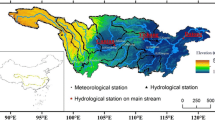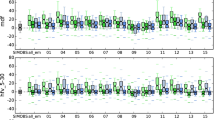Abstract
The potential effects of climate change on the hydrology and water resources of the Columbia River Basin (CRB) were evaluated using simulations from the U.S. Department of Energy and National Center for Atmospheric Research Parallel Climate Model (DOE/NCAR PCM). This study focuses on three climate projections for the 21st century based on a `business as usual' (BAU) global emissions scenario, evaluated with respect to a control climate scenario based on static 1995 emissions. Time-varying monthly PCM temperature and precipitation changes were statistically downscaled and temporally disaggregated to produce daily forcings that drove a macro-scale hydrologic simulation model of the Columbia River basin at 1/4-degree spatial resolution. For comparison with the direct statistical downscaling approach, a dynamical downscaling approach using a regional climate model (RCM) was also used to derive hydrologic model forcings for 20-year subsets from the PCM control climate (1995–2015) scenario and from the three BAU climate(2040–2060) projections. The statistically downscaled PCM scenario results were assessed for three analysis periods (denoted Periods 1–3: 2010–2039,2040–2069, 2070–2098) in which changes in annual average temperature were +0.5,+1.3 and +2.1 °C, respectively, while critical winter season precipitation changes were –3, +5 and +1 percent. For RCM, the predicted temperature change for the 2040–2060 period was +1.2 °C and the average winter precipitation change was –3 percent, relative to the RCM controlclimate. Due to the modest changes in winter precipitation, temperature changes dominated the simulated hydrologic effects by reducing winter snow accumulation, thus shifting summer streamflow to the winter. The hydrologic changes caused increased competition for reservoir storage between firm hydropower and instream flow targets developed pursuant to the Endangered Species Act listing of Columbia River salmonids. We examined several alternative reservoir operating policies designed to mitigate reservoir system performance losses. In general, the combination of earlier reservoir refill with greater storage allocations for instream flow targets mitigated some of the negative impacts to flow, but only with significant losses in firm hydropower production (ranging from –9 percent in Period1 to –35 percent for RCM). Simulated hydropower revenue changes were lessthan 5 percent for all scenarios, however, primarily due to small changes inannual runoff.
Similar content being viewed by others
References
BPA (Bonneville Power Administration), U.S. Army Corps of Engineers, and U.S. Bureau of Reclamation: 2001, The Columbia River System: The Inside Story, 2nd edn., Report DOE/BPA–Published for the Columbia River System Review by the COE and USBR.
Christensen, N. S., Wood, A. W., Lettenmaier, D. P., and Palmer, R. N.: 2004, ‘Effects of Climate Change on the Hydrology and Water Resources of the Colorado River Basin’, Clim. Change 62, 337–363.
COE NPD (U.S. Army Corps of Engineers, North Pacific Division): 1991, Columbia River and Tributaries Review Study: Review of Flood Control, COE Report.
Dai, A., Washington, W. M., Meehl, G. A., Bettge T.W., and Strand, W. G.: 2004, ‘The ACPI Climate Change Simulations’, Clim. Change 62, 29–43.
Giorgi, F., Hurrell, J. W., Marinucci, M. R., and Beniston, M.: 1997, ‘Elevation Dependency of the Surface Climate Signal: A Model Study’, J. Climate 10, 288–296.
Gleick, P. H. and Chaleki, E. L.: 1999, ‘The Impacts of Climatic Changes for Water Resources of the Colorado and Sacramento-San Joaquin River Basins’, J. Amer. W. Res. Assn. 35 (6), 1429–1441.
Hamlet, A. F., Huppert, D., and Lettenmaier, D. P.: 2002, ‘Economic Value of Long-Lead Streamflow Forecasts for Columbia River Hydropower’, J. Water Plan. & Mgmt.-ASCE 128 (2), 91–101.
Hamlet, A. F. and Lettenmaier, D. P.: 1999, ‘Effects of Climate Change on Hydrology and Water Resources in the Columbia River Basin’, J. Amer. W. Res. Assn. 35 (6), 1597–1623.
Lettenmaier, D. P., Brettman, K. L., Vail, L. W., Yabusaki, S. B., and Scott, M. J.: 1992, ‘Sensitivity of Pacific Northwest Water Resources to Global Warming’, Northwest Envir. J. 8 (2), 265–283.
Lettenmaier, D. P. and Gan, T.-Y.: 1990, ‘Hydrologic Sensitivities of the Sacramento-San Joaquin River Basin, California, to Climate Change’, Water Resour. Res. 26, 69–86.
Lettenmaier, D. P. and Sheer, D. P.: 1991, ‘Climatic Sensitivity of California Water Resources’, J. Water Res. Plan. & Mgmt. 117 (1), 108–125.
Lettenmaier, D. P., Wood, A. W., Palmer, R. N., Wood, E. F., and Stakhiv, E. Z.: 1999, ‘Water Resources Implications of Global Warming: A U.S. Regional Perspective’, Clim. Change 43 (3), 537–579.
Leung, L. R. and Ghan, S. J.: 1998, ‘Parameterizing Subgrid Orographic Precipitation and Surface Cover in Climate Models’, Mon. Wea. Rev. 126 (12), 3271–3291.
Leung, L. R. and Ghan, S. J.: 1999, ‘Pacific Northwest Climate Sensitivity Simulated by a Regional ClimateModel Driven by a GCM. Part II: 2 x CO(2) Simulations’, J. Climate 12 (7), 2031–2053.
Leung, L. R., Qian, Y., and Bian, X.: 2003, ‘Hydroclimate of the Western United States Based on Observations and Regional Climate Simulation of 1981-2000. Part I: Seasonal Statistics’, J. Climate 16 (12), 1892–1911.
Leung, L. R., Qian, Y., Bian, X., Washington, W. M., Han, J., and Roads, J. O.: 2004, ‘Mid-Century Ensemble Regional Climate Change Scenarios for the Western United States’, Clim. Change 62, 75–113.
Liang, X., Lettenmaier, D. P., Wood, E. F., and Burges, S. J.: 1994, ‘A Simple Hydrologically Based Model of Land Surface Water and Energy Fluxes for General Circulation Models’, J. Geophys. Res. 99 (D7), 14415–14428.
Martin, K.: 2001, ‘Hydro Recommendations to Counter Global Warming in the Pacific Northwest: CRITFC's Natural-Peaking Hydrograph’, Memo to University of Washington's Climate Impacts Group, Oct.
Maurer, E. P., Lettenmaier, D. P., and Roads, J. O.: 1999, ‘Water Balance of the Mississippi River Basin from a Macroscale Hydrologic Model and NCEP/NCAR Reanalysis’, EOS, Transactions of the American Geophysical Union 80 (46), F409–410.
Maurer, E. P., Wood, A. W., Adam, J. C., Lettenmaier, D. P., and Nijssen, B.: 2002, ‘A Long-Term Hydrologically-Based Data Set of Land Surface Fluxes and States for the Conterminous United States’, J. Climate 15, 3237–3251.
McCabe, G. J. and Wolock, D. M.: 1999, ‘General-Circulation-Model Simulations of Future Snowpack in the Western United States’, J. Amer. Water Res. Assn. 35 (6), 1473–1484.
Miles, E. L., Snover, A. K., Hamlet, A. F., Callahan, B., and Fluharty, D.: 2000, ‘Pacific Northwest Regional Assessment: The Impacts of Climate Variability and Climate Change on the Water Resources of the Columbia River Basin’, J. Amer. Water Res. Assn. 36 (2), 399–420.
Mote P. (ed.) and co-authors: 1999, ‘Impacts of Climate Variability and Change: Pacific Northwest, Regional Report for the PNW to the National Assessment of the Impacts of Climate Variability and Change’, JISAO Climate Impacts Group, University of Washington, Nov.
Nijssen, B., Lettenmaier, D. P., Liang, X., Wetzel, S. W., and Wood, E. F.: 1997, ‘Streamflow Simulation for Continental-Scale River Basins’, Water Resour. Res. 33 (4), 711–724.
Nijssen, B., O'Donnell, G. M., Hamlet, A. F., and Lettenmaier, D. P.: 2001, ‘Hydrologic Sensitivity of Global Rivers to Climate Change’, Clim. Change 50 (1-2), 143–175.
NMFS (National Marine Fisheries Service): 1995, Final 1995 FCRPS Biological Opinion, NOAA Publication.
NMFS: 2000, Final 2000 FCRPS Biological Opinion, NOAA Publication.
Pierce, D.W., Barnett, T. P., Tokmakian, R., Semtner, A., Maltrud, M., Lysnc, J., and Craig, A.: 2004, ‘The ACPI Project, Element 1: Initializing a Coupled Climate Model from Observed Conditions’, Clim. Change 62, 13–28.
VanRheenen, N. T., Wood, A. W., Palmer, R. N., and Lettenmaier, D. P.: 2004, ‘Potential Implications of PCM Climate Change Scenarios for California Hydrology and Water Resources’, Clim. Change 62, 257–281.
Washington, W. M., Weatherly, J. W., Meehl, G. A., Semtner, A. J., Bettge, T.W., Craig, A. P., Strand, W. G., Arblaster, J., Wayland, V. B., James, R., and Zhang, Y.: 2000, ‘Parallel Climate Model (PCM) Control and Transient Simulations’, Clim. Dyn. 16 (10-11), 755–774.
Wood, A. W., Leung, L.-Y., Sridhar, V., and Lettenmaier, D. P.: 2004, ‘Downscaling Climate Model Surface Precipitation and Temperature: A Comparison of Methods, Clim. Change 62, 189–216.
Wood, A. W., Maurer, E. P., Kumar, A., and D. P. Lettenmaier: 2002, ‘Long Range Experimental Hydrologic Forecasting for the Eastern U.S.’, J. Geophys. Res. 107 (D20), 4429, doi:10.1029/2001JD000659.
Author information
Authors and Affiliations
Rights and permissions
About this article
Cite this article
Payne, J.T., Wood, A.W., Hamlet, A.F. et al. Mitigating the Effects of Climate Change on the Water Resources of the Columbia River Basin. Climatic Change 62, 233–256 (2004). https://doi.org/10.1023/B:CLIM.0000013694.18154.d6
Issue Date:
DOI: https://doi.org/10.1023/B:CLIM.0000013694.18154.d6




